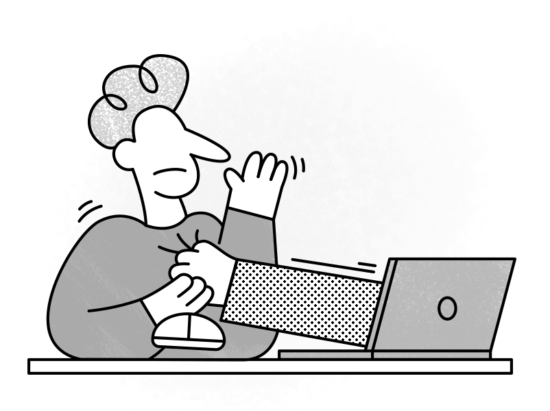Have you ever thought about the aspects that separate online shop visitors from actual customers?
Have you ever thought about the journey site visitors go through before they purchase products? No? Perhaps you should have.
When potential customers shop on an e-commerce website, they are not just visiting product pages; they are taking into account other elements.
They are considering product prices, quality/price ratio, shipping costs, shipping, and return policy, import duties and customs charges, what they have heard about your company/products from their friends and family, etc. They are also debating whether the products they are interested in buying can “satisfy their needs” and improve their quality of life.
Your role as an e-commerce site owner is to make their decision process as quick as possible by offering them the best possible solutions, such as free shipping, no customs charges, etc. But if you are not in a position to provide such benefits, you can focus on what you can control: persuading potential customers that your products are just what they need.
How to do so?
Well, for starters, you can add high-quality imagery of your products. Even videos. And then, you can focus on writing compelling, well-structured project descriptions.
If you need help writing product descriptions, these 7 rules will guide you through the process and ensure you create the best product descriptions possible. Let’s go through all of them.
Rule #1: Know your target audience to the core.
One of the essential rules of copywriting is to know for whom you are writing the text. And you can apply this rule when writing project descriptions. So, before you start writing product descriptions, create profiles of potential customers you are trying to target.
Here’s why this step is so crucial.
Imagine that you run an e-commerce website that sells high-end hair care, body care, skin care, shaving, and beard care to men. Your shop has all kinds of organic, high-quality washes, soaps, shower gels, shampoos, razors, timmers, etc. Now, imagine that one of the product descriptions for a high-priced trimmer on your site is: This trimmer will satisfy all your grooming needs. It comes in three colors, and you’ll enjoy using it. You won’t have a problem cleaning it up, and it won’t take up much space in the bathroom cabinet.
Hmm… Is that the most impressive product description you’ve ever read? Probably not.
The first thing that is wrong with the description is that it doesn’t include all the necessary information about the product 一 there is no data on the battery type, no data on the cord (or the lack of it), no information about the length settings, blades, etc. Second, the “you’ll enjoy using it” part doesn’t really explain much about the product’s use or purpose. And third, a man buying a quality trimmer is probably not that concerned about how much space the trimmer will take up in a bathroom cabinet. The whole copy doesn’t really make sense at all.
So, considering the products you sell are on the pricier side and are created for men, you can be pretty sure that your customers won’t be 13-year-old girls or 90-year-old ladies that don’t even know how to turn the computer on. Your primary target audience is men, aged between 20 and 60, who like to take care of their skin and body hair and can afford more expensive products.
By defining your customer profiles, you’ll be able to determine which product features your potential customers will find of value the most. Before writing product descriptions, think about your customers’ interests and which product features would be the most interesting to them or the most beneficial for them. You can also think about how your customers would explain your products to their friends or family members and include such descriptions in the product tex t.
Rule #2: Include product features and product benefits.
The secret to writing compelling product descriptions is finding the right balance between product features and product benefits.
Products’ features are technical product information. They are factual statements that cannot be changed.
Product benefits give customers insights into how a product can change and improve their life.
So, before you begin typing, list all features and benefits of each product. If you have an issue with writing down benefits, just think how a product can reduce a customer’s pain or increase pleasure.
Ideally, for every feature described, you should be able to define a direct benefit for the buyer.
If you are not sure what we mean, here’s an example.
If you are writing a project description for a highly-priced trimmer, one of the product features can be battery type. For example, you can mention that the trimmer comes with a cordless Lithium Ion (Li-Ion) battery and that such a battery lasts up to three years, and that they don’t have to worry about constantly charging the trimmer, as one regular charge is all that’s needed.
See what we did there?
The first part of the sentence一“the trimmer comes with a cordless Lithium Ion battery” 一 is a product feature, and the second part一“you won’t have to worry about constantly charging the trimmer, as one regular charge is all that’s needed” is a product benefit.
Transforming features into benefits is not an easy task, so take your time and practice.
Note: When writing product features benefits, make sure you are being specific as possible. Avoid the phrases like “it’s a high-quality product you’ll love”, “the product quality is excellent”. These types of phrases don’t add value to your product description and won’t make potential customers want to buy the products; if anything, the phrases will make them yawn, say “Yeah, right!” and close the tab on your site.
Rule #3: Give a background story on a product (to evoke an emotion).
Writing products’ features and benefits will do the job just fine, but if you really want to persuade potential customers to buy, you need an extra punch. You need to allow customers to connect with a product more personally and emotionally.
Here’s how to do so.
Let’s go back to the example with the trimmer.
Suppose you want potential customers to feel special and persuade them to buy the product. In that case, you could write something along the line: The trimmer is built as an uncanny copy of the famous [product name] which Winston Churchill, the Prime Minister that led Britain successfully through the Second World War, used. The carefully built blades are resistant to corrosion, and its non-porous surface makes it very easy to clean.
By including the mini-story about a product, customers will be able to connect with your products on an emotional level.
If you are having a hard time coming up with these short stories, try to answer these questions:
- Who originally made the product?
- When/where was the product made?
- Are there any interesting facts about the product material?
- Does any celebrity or famous person use this product?
Rule #4: Use a friendly tone and voice when describing products.
When it comes to the tone and voice you are going to use when describing products, we have one rule: when you read the description out loud, it needs to sound like you are describing a product to a friend. This means that you shouldn’t use imperatives, or negative terms: the tone and the voice you use need to be conversational and friendly.
Let’s go back to the trimmer example and imagine that you have been using that trimmer for a couple of months. If you wanted to describe that trimmer to a friend, you would probably mention whether it is easy to use or if it helps you reach all the areas on your face. You would presumably mention the product’s battery life and whether you are having an easy or hard time holding the trimmer while grooming. Are we right?
And all of this information can quickly be transformed into a product description: [Product name] is equipped for any man’s grooming needs. Whether you want to maintain your three-day, stubble beard or keep it bushy, the [Product name], with 5 adjustable length settings, will clean up hair no matter the length. It features a sleek, matte black finish and charges in just a few hours, thanks to its cordless Lithium Ion battery. [Product name] comes with an ergonomic design that is easy to grip and maneuver around all the hard-to-reach areas. It can be used with or without a cord.
Sounds so simple, doesn’t it?
Rule #5: Pay attention to the styling of each product description.
According to Nielsen Norman Group, on an average web page, users read 20% of the words during an average visit.
And this data is from 2008.
How many words do you think an average user reads on a web page in 2023? Fifteen, ten, five percent of the page copy? Perhaps less?
The point is that even high-literacy users only skim through the text. They don’t read the whole text; they want to find only the information that interests them. However, if users like the product so much they think about buying it, they will read the full product description.
Knowing this, your product descriptions must be optimized for skimming and scanning. We suggest you include bullet points and write short paragraphs. You can use different font sizes to emphasize certain product features or benefits.
Rule #6: Make product descriptions SEO-friendly.
Before you publish each product description, make sure that the content (both copy and product images) is optimized for search engines. By doing so, search engines will be able to find your pages more quickly and rank your site higher, resulting in more increased traffic, and, ultimately, high conversions.
The optimization process begins with finding the right keywords to include on each product page. When doing keyword research, we advise you to start with a keyword planning tool; you can use Google’s Keyword Planner一it’s free. It allows you to type words in different languages, check what people search in different parts of the world, and do some advanced filtering. Doing this step will give you an idea of what keywords are performing well on search engines and can be used on your product pages.
Once you are done searching, you can easily download all the keywords you found.
After you find the right keywords, and variations of them, include them in the page titles, product descriptions, image tags (ALT tags), and product descriptions.
Note: In the post in which we listed 10 things you can learn from the best shopping sites, we mentioned that including high-resolution photos and videos of your products is a must. Potential customers love seeing a product in several different lights and environments, especially if you sell high-end, premium products. So, once you are done writing product descriptions, don’t forget to add several, visually-appealing images and videos of each of your products.
Rule #7: Once you are done writing product descriptions, proofread them.
Once you feel that the product description text looks good, don’t rush and click the Publish button.
Read over your product descriptions (as many times as you need), just to ensure there are no typos. You can use tools like Grammarly to avoid spelling and grammar mistakes.
Conclusion
Writing product descriptions is a challenging task. But, with a little bit of patience and a lot of practice, you’ll get the hang of it and be able to create descriptions that sell.
Good luck, and may your product descriptions increase conversions!
And if you like reading about e-commerce and business-related, be sure to subscribe to the Themes Kingdom newsletter and follow us on Facebook, Instagram, and Twitter.



